Discover 7 hidden attractions, cool sights, and unusual things to do in Lansing (United States). Don't miss out on these must-see attractions: Black Hawk Bridge, Mount Hosmer, and Old Allamakee County Courthouse. Also, be sure to include Lansing Stone School in your itinerary.
Below, you can find the list of the most amazing places you should visit in Lansing (Iowa).
Table of Contents
Black Hawk Bridge
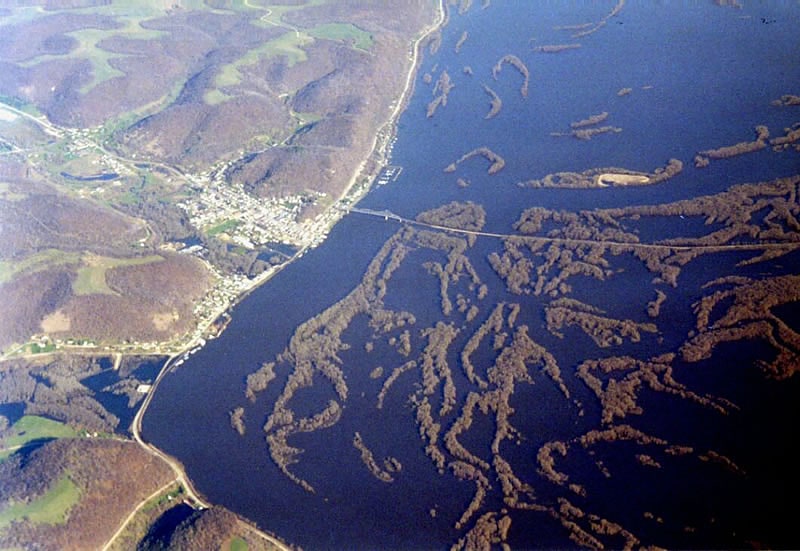
Cantilever bridge. The Black Hawk Bridge spans the Mississippi River, joining the town of Lansing, in Allamakee County, Iowa, to rural Crawford County, Wisconsin. It is the northernmost Mississippi River bridge in Iowa.
Named for Chief Black Hawk, it is popularly referred to as the "Lansing bridge". It carries Iowa Highway 9 and Wisconsin Highway 82.
This riveted cantilever through truss bridge has one of the more unusual designs of any Mississippi River bridge. Construction started in 1929 and was completed in 1931. The designer and chief engineer was Melvin B. Stone. The McClintic-Marshall Company of Chicago erected the trusses. The steel came from the Inland Steel Company.
The Wisconsin approach has a long causeway over Winneshiek bottoms (sloughs, ponds, and backwaters) before ramping up to the bridge itself. The main shipping channel is on the Iowa side. The Iowa approach is rather abrupt, going from a 25 miles per hour (40 km/h) city street straight up a steep ramp onto the bridge.
Originally a privately built and operated bridge owned by the Iowa-Wisconsin Bridge Company, it was closed between 1945 and 1957, due to damage from ice damming, and lacking funds to repair the bridge, the company went out of business. The two states acquired the bridge and repaired it.
In August 2011 the bridge was briefly closed for repairs after a crack was found in a floor beam.
Replacement
The bridge has a sufficiency rating of 39.9 percent, which mainly reflects its obsolete nature. The Iowa Department of Transportation is planning for a replacement bridge to start construction in 2024. It was revealed during a meeting on June 15, 2021, that the replacement bridge's design would look extremely similar to the current bridge's design while either retaining the pier's design or adopting a newer wave design.[1]
Address: Iowa Hwy 9 / Wisconsin Hwy 82, 52151 Lansing
Mount Hosmer
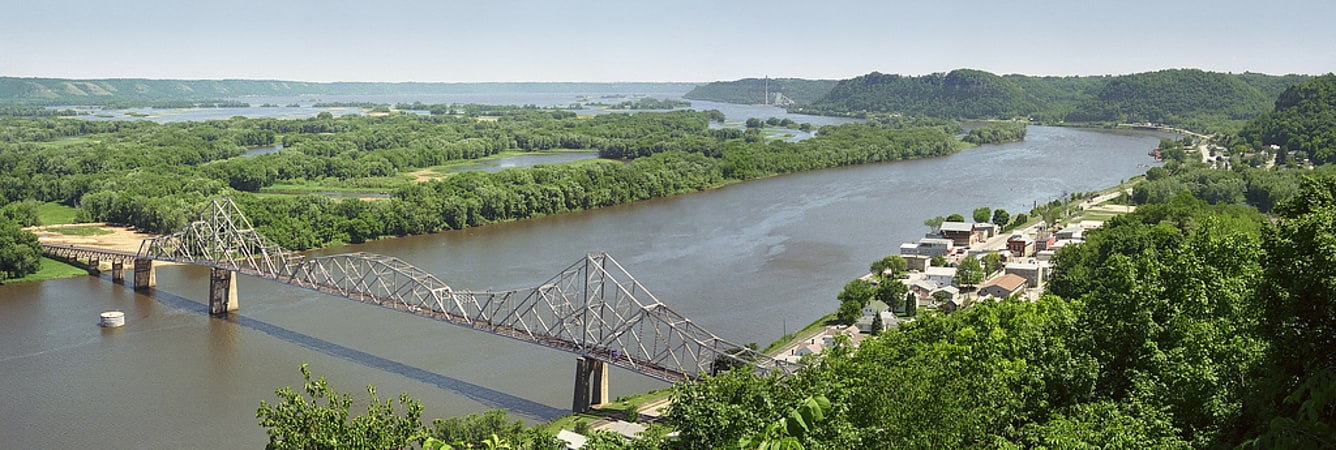
Park in Iowa. Mount Hosmer is a bluff overlooking Lansing, Iowa. It is located directly adjacent to the Upper Mississippi River and offers a panoramic view of the river, including the Black Hawk Bridge. Mount Hosmer rises 450 feet above downtown Lansing.
Accessible from Lansing, Mount Hosmer Park is a popular destination for photographers. According to a plaque inside the park, Mount Hosmer is named for Harriet Hosmer, a sculptor, who won a footrace to the summit of the hill during a steamboat layover during the 1850s.[2]
Old Allamakee County Courthouse

Courthouse. The Old Allamakee County Courthouse, located on 2nd Street in Lansing, is a short-lived former county courthouse of Allamakee County, Iowa. The courthouse was completed in 1861 amid a fight between Lansing and Waukon over which community deserved to be the county seat. Lansing had lost a vote on the county seat to Waukon in 1859, but they won another vote in 1861 after teaming up with the community of Columbus. Waukon built its own courthouse in the meantime, but it failed to win back the county seat in yet another vote in 1864. The county sheriff, a Waukon resident, attempted to seize the county's records from the Lansing courthouse in 1866; however, a posse from Lansing stopped him before he could return to Waukon. The Iowa Supreme Court decided the county seat battle in favor of Waukon the following year; it has remained there since.
The Lansing courthouse is now one of the only Greek Revival courthouses remaining in Iowa. The building features a recessed portico at the front entrance and curved stairways in its front corners, features not seen in any other Iowa courthouse.
The courthouse was added to the National Register of Historic Places of February 24, 1983.[3]
Lansing Stone School
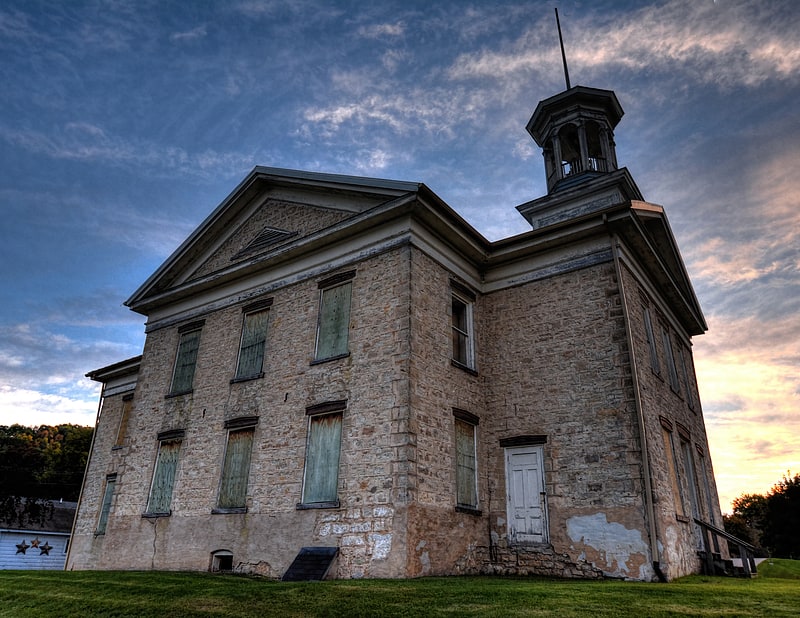
Lansing Stone School is a historic building located in Lansing, Iowa, United States. The two story structure was constructed in 1864 using locally quarried limestone. The cupola on the center front of the building is original. The building was enlarged in 1867 when the wings on the north and south sides were added. It served as a school building for 108 years. It was listed on the National Register of Historic Places in 1973.[4]
Lansing Fisheries Building
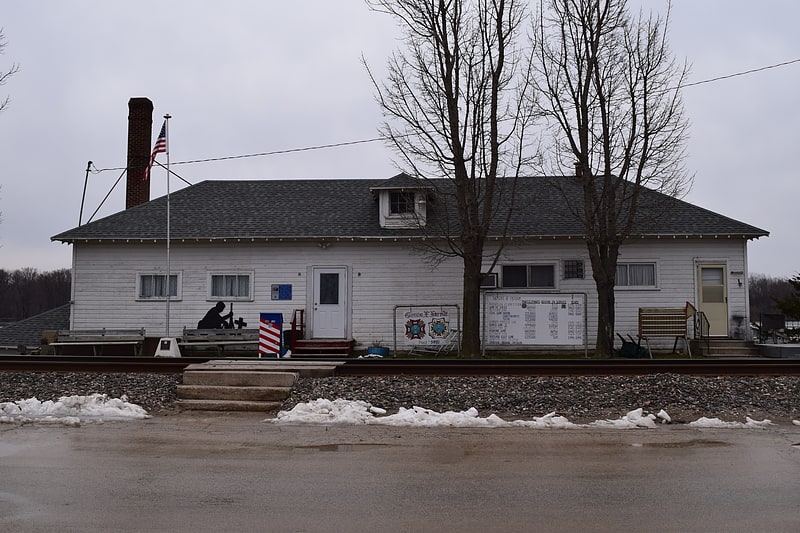
Lansing Fisheries Building, also known as the Lansing Fish Hatchery/Lansing Fish Rescue Station, is a historic building located in Lansing, Iowa, United States. Lansing was long associated with fish rescue work along the Mississippi River. Fish would get caught in the backwaters and would suffocate when the water levels dropped or froze to death in the shallow waters in winter. Rescued fish would either be redeposited in the river or transported inland to stock streams and lakes by the State Fish and Game Warden.
This building was constructed by the Iowa State Fish and Game Warden in 1915 as a headquarters for fish rescue, and as a fish hatchery. The facility was along the Chicago, Milwaukee and St. Paul Railroad tracks, and it and other railroads in the state would transport fish for the state for a nominal fee in specially designed cars for stocking purposes. In the 1930s the Lansing facility became the headquarters for fish management in eastern Iowa. Rescue efforts were discontinued in the 1940s, but the facility remained a hatchery into the late 1970s. Luther College leased the building in 1981 for an onsite laboratory. Beginning in 1984 the Lansing chapter of the Veterans of Foreign Wars began leasing the building. It was listed on the National Register of Historic Places in 1991.[5]
G. Kerndt and Brothers Elevator and Warehouses
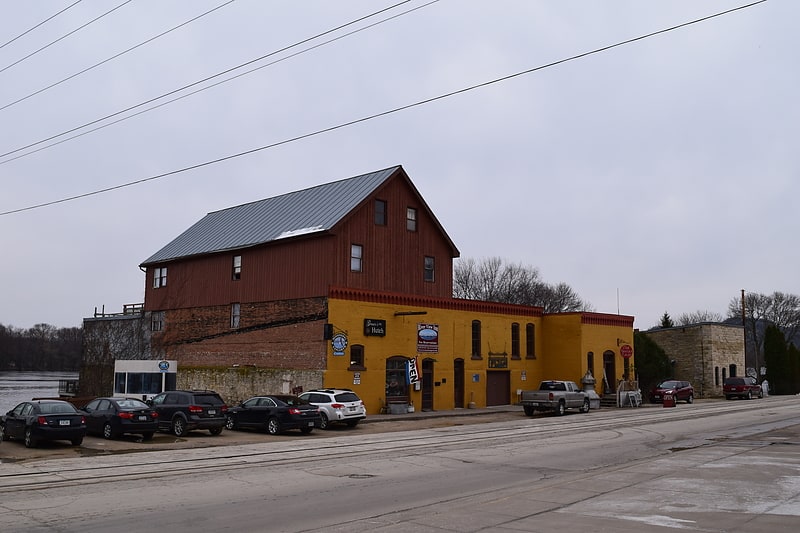
G. Kerndt and Brothers Elevator and Warehouses, No. 11, No.12 and No. 13 is a historic complex located in Lansing, Iowa, United States. The four Kerndt brothers were all German immigrants who settled in the Lansing area by 1854. Gustav, William and Mortiz established a broom factory and cigar business in town while Herman farmed and provided the broom corn for the factory. A fifth brother, Julian, died shortly after arriving in Iowa. They built their first grain warehouse in the late 1850s. In 1861 they began their general store, which would in time include private banking as a part of their mercantile business. In 1908 it was incorporated by the family as the Kerndt Brothers Savings Bank.
The first floor on the north side of this building was completed in 1868, and was known as warehouses 11 and 12. The elevator portion of the building was added in 1890. It is the upper portion with the gable roof. Warehouse 13 is the section on the south side of the building that projects forward. The main floor of the building is brick, and built on a basement of native limestone. The basement is exposed in the back, and it extends to the edge of the Mississippi River. The upper section where the grain elevator was located is a frame structure that was originally faced with corrugated metal. At the time of its nomination the grain elevator machinery was still in place. The building now houses several different commercial enterprises. It was listed on the National Register of Historic Places in 1979, and it was included as a contributing property in the Lansing Main Street Historic District in 2014.[6]
G. Kerndt & Brothers Office Block

G. Kerndt & Brothers Office Block, also known as the Kerndt Brothers Building, is a historic building located in Lansing, Iowa, United States. The four Kerndt brothers were all German immigrants who settled in the Lansing area by 1854. Gustav, William and Mortiz established a broom factory and cigar business in town while Herman farmed and provided the broom corn for the factory. In 1861 they built the first part of this building to house their general store. They were so successful they expanded the building in 1866. In addition to the store they also owned a gran elevator along the Mississippi River. Added to this they started in private banking as a part of their mercantile business. In 1908 it was incorporated by the family as the Kerndt Brothers Savings Bank. This building now houses the Kerndt Brothers Savings Bank Community Center.
The commercial Italianate building is a three-story brick structure. It features a simple cornice, a rounded corner, and two storefronts. The iron balconies on the second and third floors of the rounded corner are recreations of the originals. The building was listed on the National Register of Historic Places in 1982, and it was included as a contributing property in the Lansing Main Street Historic District in 2014.[7]